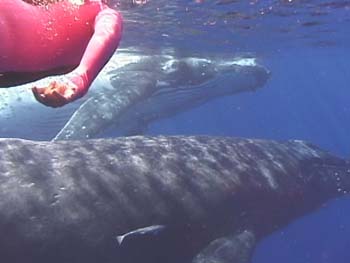Is there a "right" way?

Picture this. Two humpback whales glide beneath you in a synchronous ballet amid shafts of converging sunlight, their bulbous probing eyes staring into you as they twist their massive pectoral fins to glide, tumble and coil for several precious minutes before a single pulse of their flukes propels them beyond your vision.
Encounters with whales in the wild are either fast, furious and frequently unsuccessful - not to mention frightening for the whales - or they are slow, deliberate and as fascinating as they are exhilarating. It's either the hunt-and-chase approach or the mutual curiosity game. We choose the latter, gentler, safer way which is, of course, also the most fulfilling for swimmers and photographers. Whales are very intelligent and social. Often individuals will come close to check us out several times over, providing we are calm, patient and cohesive in the water. It is crucial that we carefully nurture their trust and inquisitiveness, not scare them away.
"If a whale is nearby, slide into the water, make like a jellyfish and keep your eyes open. The whale will come to you," believes the Whaleman Foundation's Jeff Pantukoff, who led one of 1998's expeditions along with whale artist Wyland.
The swimming-with-whales debate is an interesting one which we have discussed at length. Some scientists believe that the gain from swimming with a whale does not out-weigh the risk of frightening it away from boats and people. But there are worthwhile scientific gains to be had from moments underwater close enough to a whale to determine it's sex, observe the movement of it's bulky -- yet highly sensitive body, see and film scars or distinguishing marks, or document standard behavior or physiology. Their reaction to us underwater, and on the surface for that matter, is an important aspect of understanding them.
Best of all, the experience of swimming with a whale is so profound and the memories and images brought back from an in-water encounter are so exciting that it can change the way people see nature, understand it and, in turn, care for it. "We will save what we love" said the late Jacques-Yves Cousteau. True. But equally so is his son Jean-Michel's follow-through,"We will love what we understand."
The question is not SHOULD we swim with whales, but WHEN and HOW to do it?
The answer is as clear as Tonga's sapphire depths. Don't harass the whales. Wait until they come to you. A key to successful encounters is to choose the right whale. Some are protecting calves, some are in a hurry to get somewhere, some want peace, and some are curious and playful. The gentler option is sometimes counterintuitive for people who have traveled great distances, paid lots of money, and pinned their lifetime hopes on gazing into a humpback's craggy wise old eye!
But our patience and sensitivity has paid remarkable dividends over the years. We've snorkeled with humpbacks on many occasions, sometimes spending an hour or more on single encounters. Each time we swim with these creatures - lone whales, pairs, males, females - the whales call the shots.
Chasing them and attempting to intercept their path is an intimidating and entirely pointless exercise. But waiting patiently, the engine constantly humming rather than revving in pursuit, seems to encourage their curious nature.
The whales definitely prefer NAI'A to our fast and noisy skiffs, so we plan the great majority of snorkeling from the mother ship. When they surface freely next to NAI'A, we try our luck in the water, dropping in off the stern swimdeck or from the skiffs trailing on long lines astern. Often the whales hang around NAI'A, and snorkelers are rewarded with long, sustained interactions.
Unfortunately, the common-sense approach to swimming with whales sometimes breaks down, especially under pressure from multiple operators attempting to swim with the same whale. Due to increasing pressure on whales from whalewatching enthusiasts in Vava'u, Tonga has enacted legislation governing whale swims. The regulations are reasonable and the result of many years of experience with commercial whale swim operations. Among other things, the regulations restrict the number of people allowed in the water per whale, the way a whale is approached, and how close the boat can get. The regulations also prohibit scuba diving with whales in Tonga.
